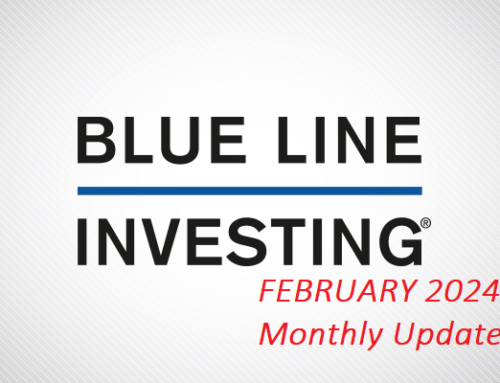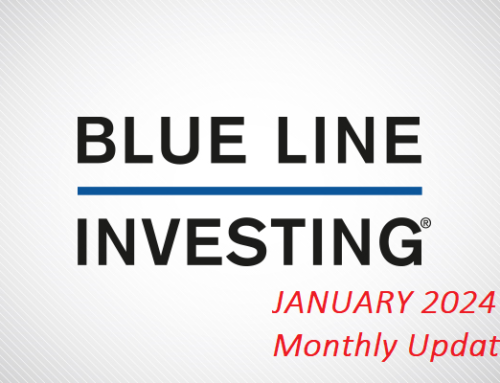In our recent BLI Market View, published November 3, 2017, we commented on how the current stock market seems to be “behaving” similarly to 1995. In this article we will illustrate what we meant by that statement.
Before proceeding however, we want to make one clarification. The “Blue Line” is not the only indicator we use within our investment process. There are other technical indicators we follow, and it is how price “behaves” in relation to each and every other indicator – individually and cohesively – that is of consequence. The other indicators include, but are not limited to, the “Green” and “Purple” lines as well. We simply reference the “Blue Line” to keep the concept simple.
How we use BLUE LINE INVESTING¹ to attempt to identify a BULL MARKET
From our research and years of experience, we believe the strongest bull markets form a particular pattern. Specifically, when price rises and remains above the Green Line, and the Green Line remains above the Purple Line, and the Purple Line remains above the Blue Line, we believe the investment being observed is in a bull market (i.e. Positive Primary Trend).
Consider the S&P 500 Index² (S&P) during 1995 as shown below:

From the chart above we can observe that when prices corrected during this bull market they were shallow and tended to bounce off of the Green Line, and occasionally, the Purple Line. Price corrections to the Blue Line tended to be rare, but when they occurred, they tended to be sharp and quick.
Compare the chart above to the one below that has been updated for the current calendar year:

Since the election last November, the S&P has exhibited a similar pattern to that of 1995. Price corrections have been relatively shallow; often bouncing off the Green Line, and occasionally the Purple Line. So far we continue to wait for another “test” of the Blue Line. As a reminder, the Blue Line represents our preferred point of purchase for any new investment or when purchasing into our strategies for new clients.
It is important to note that this pattern has no predictive capability, nor does it infer that the past is likely to repeat. We simply monitor this pattern, along with other indicators, to attempt to determine if the existing bullish trend is likely to continue over the coming days and weeks, or if a price correction or price “top” is becoming more likely.
We have also found that this pattern is not limited to any one market or sector. The following charts of the PowerShares Aerospace and Defense Portfolio ETF³ and the First Trust NASDAQ-100 Technology Sector Index ETF⁴ have been exhibiting this behavior as well.


The BLUE LINE INVESTING™ process uses this pattern to attempt to identify bullish trends across many financial markets and sectors. Once identified, we use various relationships between price and the indicators to pinpoint where purchase and/or sell decisions should be considered.
For reference of what bearish and neutral trends look like according to our process, please visit our website at https://bluelineinvesting.com/process, and review our Case Study on the S&P from 1980 – 2015.
Thanks for reading.
Jeff Link
Disclaimers:
¹ Blue Line Investing (BLI) is an alternative to traditional wealth management. BLI uses a disciplined, rules-based investment process to seek investment opportunities, regardless of whether financial markets are rising or falling. Based on technical analysis research, the process applies trend-following using specific Exponential Moving Averages (EMAs) of the market along with other technical indicators. A moving average is a widely used indicator in technical analysis that helps smooth out past price action by filtering out the “noise” from random price fluctuations. The EMA gives bigger weight to more recent prices, compared to the SMA, or Simple Moving Average which does not. EMA’s can be calculated for any time period. Some examples include the 5 day EMA; 50 day EMA; and 150 day EMA. We have attempted to simplify this by calling the various EMAs we use in our process the “Blue”, “Purple” and “Green” lines.
² The S&P 500 Index is one of the most commonly followed equity indices, and many consider it one of the best representations of the U.S. stock market, and a bellwether for the U.S. economy. It is comprised of 500 large companies having common stock listed on the NYSE or NASDAQ. The volatility (beta) of the account may be greater or less than the index. It is not possible to invest directly in this index.
³ The PowerShares Aerospace and Defense Portfolio ETF tracks a market-cap-weighted index of US-listed stocks involved in the defense, military, homeland security and space industries.
⁴ First Trust NASDAQ-100 Technology Sector Index ETF tracks and equal-weighted index of the largest NASDAQ-listed U.S. technology stocks.
Technical analysis is a method of evaluating securities by analyzing statistics generated by market activity, such as past prices and volumes. Technical analysis attempts to predict a future stock price or direction based on market trends. The assumption is that the market follows discernible patterns and if these patterns can be identified then a prediction can be made. The risk is that markets may not always follow patterns. There are certain limitations to technical analysis research, such as the calculation results being impacted by changes in security price during periods of market volatility. Technical analysis is one of many indicators that may be used to analyze market data for investing purposes and should not be considered a guaranteed prediction of market activity. The opinions expressed are those of Blue Line Investing. The opinions referenced are as of the date of publication and are subject to change without notice. Blue Line Investing reserves the right to modify its current investment strategies based on changing market dynamics or client needs.
Past performance is not indicative of future results. This material is not financial advice or an offer to sell any product. The information contained herein should not be considered a recommendation to purchase or sell any particular security. This information is intended for educational purposes only.
Advisory services offered through Gordon Asset Management, LLC (GAM). GAM is an SEC-registered investment adviser. Registration does not imply a certain level or skill or training. More information about the advisor, its investment strategies and objectives, is included in the firm’s Form ADV Part 2, which can be obtained, at no charge, by calling (866) 216-1920. The principle office of Gordon Asset Management, LLC is located at 1007 Slater Road, Suite 200, Durham, North Carolina, 27703.




